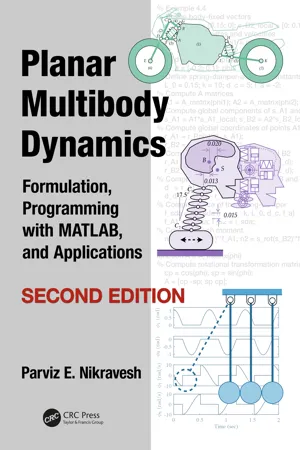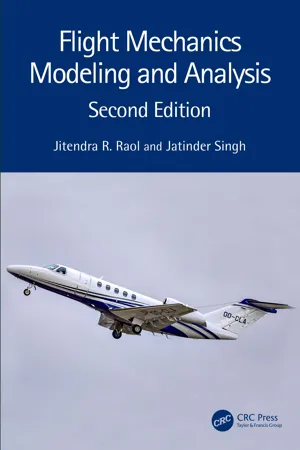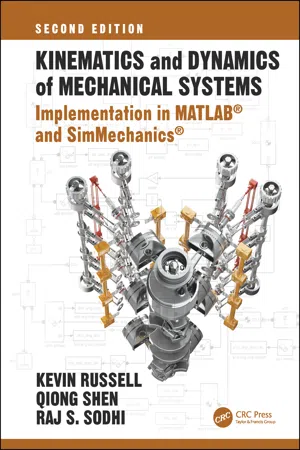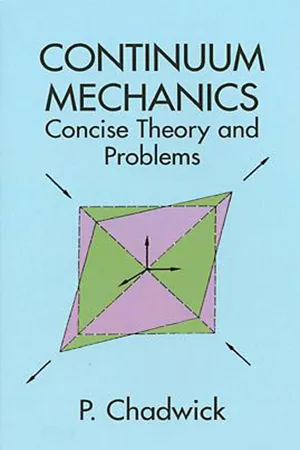Technology & Engineering
Planar Kinematics of a Rigid Body
Planar kinematics of a rigid body refers to the study of the motion of a rigid body in a two-dimensional plane. It involves analyzing the displacement, velocity, and acceleration of different points on the body. This field of study is important in understanding the movement and behavior of mechanical systems and structures.
Written by Perlego with AI-assistance
Related key terms
8 Key excerpts on "Planar Kinematics of a Rigid Body"
- eBook - ePub
Planar Multibody Dynamics
Formulation, Programming with MATLAB®, and Applications, Second Edition
- Parviz Nikravesh(Author)
- 2018(Publication Date)
- CRC Press(Publisher)
3Fundamentals of Planar Kinematics
This chapter presents a summary of some fundamental concepts of planar kinematics. We first review the kinematics of a single particle, and then we consider the fundamental formulas for the kinematics of a single planar rigid body. Definitions for arrays of coordinates, constraint equations, degrees of freedom, and kinematic joints are also discussed.The kinematic definitions and fundamental formulas for kinematics of particles and rigid bodies that are discussed in this chapter will be used extensively throughout this textbook. Therefore, it is important to understand these simple but fundamental formulas at this point. Exercises with MATLAB® are provided to carry out most of the computations, even though most of the examples are very simple and the calculations may be performed on paper. It is our intent to use MATLAB as much as possible and be prepared to solve more complex and realistic problems whenever needed.3.1 A Particle
The simplest body arising in the study of motion is a particle , or a point mass . Analysis of the behavior of a point mass can lead to the kinematic and dynamic analysis of a body, and eventually to the analysis of a system of bodies. Therefore, it is essential to study the kinematics of particles first. In this textbook, we use the terms particles and points interchangeably.3.1.1 Kinematics of a Particle
The most fundamental step in planar kinematics is to describe the position of a particle or a point in a plane. A plane is described by a nonmoving Cartesian reference frame x–y . The position of a typical particle A in the plane is described by vectoras shown in Figure 3.1 . The components of the position vectorr →A, or the x–y coordinates of particle Ar →A - eBook - ePub
- D. Gordon E. Robertson, Graham E. Caldwell, Joseph Hamill, Gary Kamen, Saunders Whittlesey(Authors)
- 2013(Publication Date)
- Human Kinetics(Publisher)
appendix C ) and mathematical principles (appendixes D and E) that are required for data collection and analysis in kinematics. Note that text in boldface is a concept described in the glossary at the end of the book.Passage contains an image
Chapter 1Planar KinematicsD. Gordon E. Robertson and Graham E. CaldwellK inematics is the study of bodies in motion without regard to the causes of the motion. It is concerned with describing and quantifying both the linear and angular positions of bodies and their time derivatives. In this chapter and the next, weexamine how to describe a body’s position;describe how to determine the number of independent quantities (called degrees of freedom) necessary to describe a point or a body in space;explain how to measure and calculate changes in linear position (displacement) and the time derivatives velocity and acceleration;define how to measure and calculate changes in angular position (angular displacement) and the time derivatives angular velocity and angular acceleration;describe how to present the results of a kinematic analysis; andexplain how to directly measure position, velocity, and acceleration by using motion capture systems or transducers.Examples showing how kinematic measurements are used in biomechanics research and, in particular, methods for processing kinematic variables for planar (two-dimensional; 2-D) analyses are presented in this chapter. In chapter 2 , additional concepts for collecting and analyzing spatial (three-dimensional; 3-D) kinematics are introduced.Kinematics is the preferred analytical tool for researchers interested in questions such as these: Who is faster? What is the range of motion of a joint? How do two motion patterns differ? An important application of kinematic data is their use as input values for inverse dynamics analyses performed to estimate the forces and moments acting across the joints of a linked system of rigid bodies (see chapters 5 , 6 , and 7 - eBook - ePub
- Jitendra R. Raol, Jatinder Singh(Authors)
- 2023(Publication Date)
- CRC Press(Publisher)
3 ]. The chapter ends with a simplified explanation of the physics behind the working of gyroscope.2.2 Kinematics
The kinematics is concerned with the static aspects of mechanics wherein the inherent cause of the motion is not taken into account.2.2.1 Rectangular Cartesian Coordinates
Rectangular Cartesian coordinates are associated with orthogonal xyz axes that are right-handed by convention. Such coordinates are generally used to define position, velocity, and force vectors. For instance, position vector can be defined in terms of its components x, y, and z. Figure 2.1 shows the components of the position vectorR →. Assuming that the components ofR →vary with time, the position vectorR →can be expressed asFIGURE 2.1 Rectangular Cartesian coordinates.(2.1)R →= x( t )i ^+ y( t )j ^+ z( t )k ^wherei ^,j ^, andk ^are unit vectors. It is easy to obtain the velocity vector by differentiating (2.1) for position vector.(2.2)V →= u( t )i ^+ v( t )j ^+ w( t )k ^Further differentiation of the equation forV →shall provide the acceleration(2.3)a →=a x( t )i ^+a yj ^+a zk ^Here,u =,x ˙v =,y ˙w =; andz ˙,a x=x ¨,a y=y ¨a z=z ¨ - eBook - ePub
Kinematics and Dynamics of Mechanical Systems, Second Edition
Implementation in MATLAB® and SimMechanics®
- Kevin Russell, John Q. Shen, Raj S. Sodhi(Authors)
- 2018(Publication Date)
- CRC Press(Publisher)
4Kinematic Analysis of Planar Mechanisms
CONCEPT OVERVIEW
In this chapter, the reader will gain a central understanding regarding- Link velocity and acceleration components in planar space
- The Newton–Raphson method for a set of two simultaneous equations
- Vector-loop-based displacement, velocity, and acceleration equation formulation and solution
- Kinematics of mechanism link locations of interest
- Instant centers in relative planar motion
- Instant center generation and application in velocity analysis
- Centrode generation and application in coupler motion replication
- Configurations of closed-loop mechanisms
- Relationships between general angular velocity and time
- Cognate construction and application
4.1 Introduction
In a kinematic analysis, positions, displacements, velocities, and accelerations of mechanism links are determined either qualitatively or quantitatively . In a quantitative kinematic analysis, equations that fully describe the motion of the mechanism links are used. Qualitative methods include constructing and measuring mechanism schematics and polygons to determine the positions, velocities, and accelerations of mechanism links. As intended by the authors, the kinematic analysis methods presented in this textbook are all quantitative. Kinematic equations for the planar four-bar, slider-crank, geared five-bar, Watt II, and Stephenson III mechanisms are formulated in this chapter. Displacement equations are formulated by taking the sum of the closed vector loop(s) in each mechanism (as introduced in Section 2.2.2 ) [1 ]. Taking the first and second derivatives of the vector-loop displacement equations introduces mechanism link velocity and acceleration variables, respectively, and, ultimately, produces mechanism velocity and acceleration equations, respectively.As noted in Section 3.1.4 , the Watt II and Stephenson III mechanisms (Figure 3.6 ) are the planar multiloop mechanisms of choice for analysis in this textbook. Both mechanisms have two links that exhibit complex motion. As illustrated in Figure 3.6 , Watt II and Stephenson III mechanisms are comprised of a planar four-bar mechanism and an additional dyad.* - eBook - ePub
Stress, Strain, and Structural Dynamics
An Interactive Handbook of Formulas, Solutions, and MATLAB Toolboxes
- Bingen Yang(Author)
- 2005(Publication Date)
- Academic Press(Publisher)
A rigid body is an object in which the distance between any two points remains the same. By definition, a rigid body does not deform, or change shape. In this section, the two-dimensional motion of slablike rigid bodies is considered.Translation
Translation is a motion in which any straight line in a body keeps the same direction during the motion; see Fig. 9.3.1 . In translation, all points of the body have the same velocity and the same acceleration, i.e.,Rotation about a Point
The rotation of a body is shown in Fig. 9.3.2 , which is a motion about an axis that is perpendicular to plane Oxy and passes reference point O . The velocity of any point P isFIGURE 9.3.1 A rigid body in translation.FIGURE 9.3.2 The rotation of a rigid body about a point.(9.73)and the acceleration at P is(9.74a)with the tangential and normal acceleration components(9.74b)Here ω is the angular velocity, ω and α are the magnitudes of the angular velocity and acceleration, and k is a unit vector that is perpendicular to plane Oxy (determined by the right-hand rule). The magnitudes of the velocity and acceleration are given by(9.75)where The angular velocity and acceleration can be expressed as(9.76)where θ is the rotational displacement of the body. The unit of θ is radians (rad), the unit of ω is rad/s, and the unit of α is rad/s2 .General Plane Motion
A general plane motion can be decomposed into a translation defined by the motion of any reference point and a simultaneous rotation about that point. For instance, let A be a reference point of the body in Fig. 9.3.3 . The velocity νB of point B is the sum of the velocity νA of the translation with A and the velocity νB/A relative to A :(9.77)Thev B/Ais a relative velocity associated with rotation about A(9.78)The angular velocity ω is independent of the reference point. In other words, any two points of a rigid body have the same angular velocity. The acceleration of point B - eBook - ePub
Continuum Mechanics
Concise Theory and Problems
- P. Chadwick(Author)
- 2012(Publication Date)
- Dover Publications(Publisher)
Chapter 2BASIC KINEMATICSKinematics is the study of motion per se, regardless of the forces causing it. The primitive concepts concerned are position, time and body, the latter abstracting into mathematical terms intuitive ideas about aggregations of matter capable of motion and deformation. In the first three sections of this chapter we develop the simple kinematic notions involved in the formulation of the field equations of continuum mechanics. The more elaborate kinematic considerations which are basic to the theoretical mechanics of elastic materials and viscous fluids are then introduced in Sections 4 to 6 .1BODIES, CONFIGURATIONS AND MOTIONSA body is a set whose elements can be put into bijective correspondence with the points of a region B of a Euclidean point space . The elements of are called particles1 and B is referred to as a configuration of ; the point in B to which a given particle of corresponds is said to be occupied by that particle. If denotes a representative particle of and x the position relative to an origin o of the point x occupied by in B, the preceding statement implies the existence of a function2 θ: → B0 and its inverse Θ: B0 → such thatIn a motion of a body the configuration changes with time. Let t be a real variable, denoting time, and I an interval (not necessarily bounded) of the reals . If, with each value of t in I, there is associated a unique configuration Bt of a body , the family of configurations {Bt : t ∈ I} is called a motion of . This definition entails the existence of functions ϕ: × I → (Bt )0 and Φ: {(x, t): t ∈ I, x ∈ (Bt )0 } → such thatIn a motion of a typical particle occupies a succession of points which together form a curve in . This curve is called the path of and is given parametrically by equation (2) 1 The velocity and the acceleration of are defined as the rates of change with time of position and velocity respectively as - eBook - ePub
Parallel Robots
Mechanics and Control
- Hamid D. Taghirad(Author)
- 2013(Publication Date)
- CRC Press(Publisher)
2
Motion Representation
In the analysis of robotic manipulators, movement of links, tools, and workpieces in the space is very important. For many other engineering disciplines such as guidance and navigation of mobile robots, airplanes, submarines, missiles, and so on, the representation of spatial location of a rigid body is also of great importance. The ideas developed for this representation originated many years ago [45], when humans were dreaming to fly and many different representations for position and orientation of a rigid body in space were developed since then. In this chapter, some of these representations are introduced with the emphasis on some new tools and descriptions, which are more suitable for robotic manipulators. Moreover, transformation from one representation to the other is also given. It should be noted that the ideas developed for position and orientation representation will form a basis for linear and angular velocity and acceleration representations, and is also adopted to represent forces and torques applied in a robotic manipulator.In order to define a mathematical representation for the location of a rigid body in the space, the first step is to define a reference coordinate system. Theoretically, it is essential that the reference coordinate system is universally fixed, in order to further develop relations for velocities and accelerations, without adopting the theory of relativity. However, in practice, we may consider a fixed coordinate system attached to the base, and due to its insignificance, neglect the effect of the relative motion of the ground in such analysis. Generally, a Cartesian coordinate system is considered for the analysis, although other types of coordinate systems, such as cylindrical or spherical coordinate systems, may also be adopted.2.1 Spatial Motion Representation
The location or pose of a rigid body with respect to a reference coordinate system is known if the positions of all its points can be determined. Three independent parameters are sufficient to fully describe the location of a rigid body in a planar motion, and six independent parameters are needed to fully describe the spatial location or pose of that in three-dimensional space. Consider a rigid body in a spatial motion as shown in Figure 2.1 . Let us define a fixed reference coordinate system (x, y, z ) denoted by frame {A }, whose origin is located at pointOA. For representation of the rigid body location, a moving coordinate system is attached to the rigid body at pointOB. As shown in Figure 2.1 , this Cartesian coordinate system (u, v, w ), which is denoted by frame {B }, has a different position and orientation from that of the fixed frame. The absolute position of a point P of the rigid body can be constructed from the relative position of that point with respect to the moving frame {B }, and the position and orientation of the moving frame {B } with respect to the fixed frame {A }. Introducing a moving frame attached to the rigid body helps us in constituting the absolute position of an arbitrary point P as by its two components, namely, relative position of that point with respect to the moving frame {B } and absolute position and orientation of frame {B } with respect to frame {A - eBook - ePub
- A. L. Stanford, J. M. Tanner(Authors)
- 2014(Publication Date)
- Academic Press(Publisher)
2 Particle Kinematics Publisher Summary This chapter provides an overview of particle kinematics. Kinematics is the branch of mechanics that describes the motion of physical bodies. It is distinguished from dynamics, which considers relationships between the motions of physical bodies and the forces (pushes or pulls) that are associated with those motions. The chapter also discusses models of physical bodies that may be considered mathematical points for the purpose of mathematical and physical analyses. A physical body may be regarded as a particle when only its translational motion is being considered, that is, when any vibrations or rotations of the body are of no consequence to the problem at hand. Large or small bodies may be treated as particles. The earth in its orbit or an automobile moving along a highway may each be thought of as a particle, provided the interest lies in its translational motion only. Perhaps the simplest example of kinematics is the motion of a particle constrained to move along a straight line. The speed of the particle at any instant is how fast the particle is moving at that instant. Its speed at a given instant is equal to the distance the particle would traverse each second if it proceeded at the rate it is moving at the given instant. Kinematics is the branch of mechanics that describes the motion of physical bodies. It is distinguished from dynamics, which considers relationships between the motions of physical bodies and the forces (pushes or pulls) that are associated with those motions. For the present we shall be interested in the kinematics of particles, models of physical bodies that may be considered mathematical points for the purpose of mathematical and physical analyses. A physical body may be regarded as a particle when only its translational motion is being considered, that is, when any vibrations or rotations of the body are of no consequence to the problem at hand. Large or small bodies may be treated as particles
Index pages curate the most relevant extracts from our library of academic textbooks. They’ve been created using an in-house natural language model (NLM), each adding context and meaning to key research topics.







